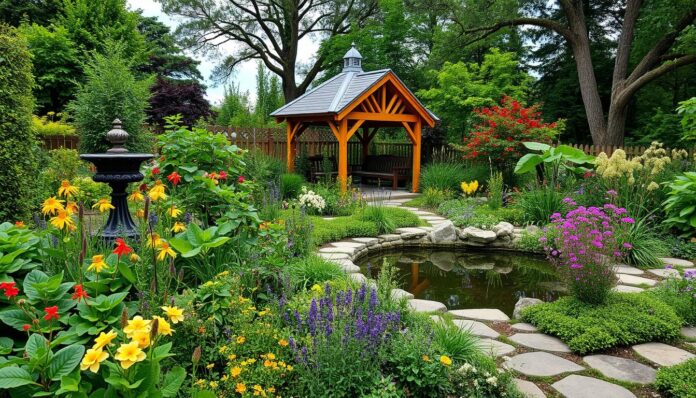Standing in my garden, I felt a deep connection to something bigger than myself. The permaculture healing environment around me was more than a landscape. It was a living, breathing ecosystem of hope and renewal.
Every plant and interaction told a story of regenerative landscapes. These landscapes could transform not just land, but human potential too.
Permaculture is more than just an agricultural technique. It’s a holistic design philosophy that changes how we see the natural world. Bill Mollison and David Holmgren started it in 1978. They aimed to create sustainable systems that support all life, from tiny microorganisms to human communities.
Our modern world often disconnects us from nature’s rhythms. Permaculture offers a radical alternative. It’s a way to design environments that heal both land and people.
By understanding natural systems and working with them, we can create spaces that nurture health. This includes physical, emotional, and ecological well-being.
Key Takeaways
- Permaculture is a holistic design approach focused on sustainability
- Regenerative landscapes can support both environmental and human well-being
- Natural systems provide powerful models for healing and restoration
- Permaculture integrates ecological design with community needs
- Creating healing environments requires observation and thoughtful interaction
Understanding Permaculture Principles
Permaculture is a new way to design places for people that also helps nature. It was started in the 1970s by Bill Mollison and David Holmgren. This method is great for fixing the environment and making places that feel natural.
Definition of Permaculture
Permaculture is all about designing like nature does. It’s more than just farming; it’s about making systems that work with nature. It mixes nature’s rules with what people need to make landscapes that are good for everyone.
Key Principles of Permaculture
- Observe and interact with natural systems
- Capture and store energy efficiently
- Obtain a yield that maximizes productivity
- Apply self-regulation and accept feedback
- Use and value renewable resources
“Permaculture is a design approach that teaches us to work with nature, not against it.” – David Holmgren
Benefits to the Environment
Permaculture helps the environment a lot by:
- Increasing biodiversity by up to 30%
- Reducing waste through comprehensive recycling
- Improving soil health and water retention
- Creating resilient, self-sustaining ecosystems
The natural design of permaculture shows how people can live in harmony with nature. This helps both the environment and people.
The Connection Between Permaculture and Healing
Permaculture is a powerful way to heal that goes beyond old methods. It creates spaces that help both people and nature. This leads to new ways to heal, like therapeutic gardens and nature-based therapy.
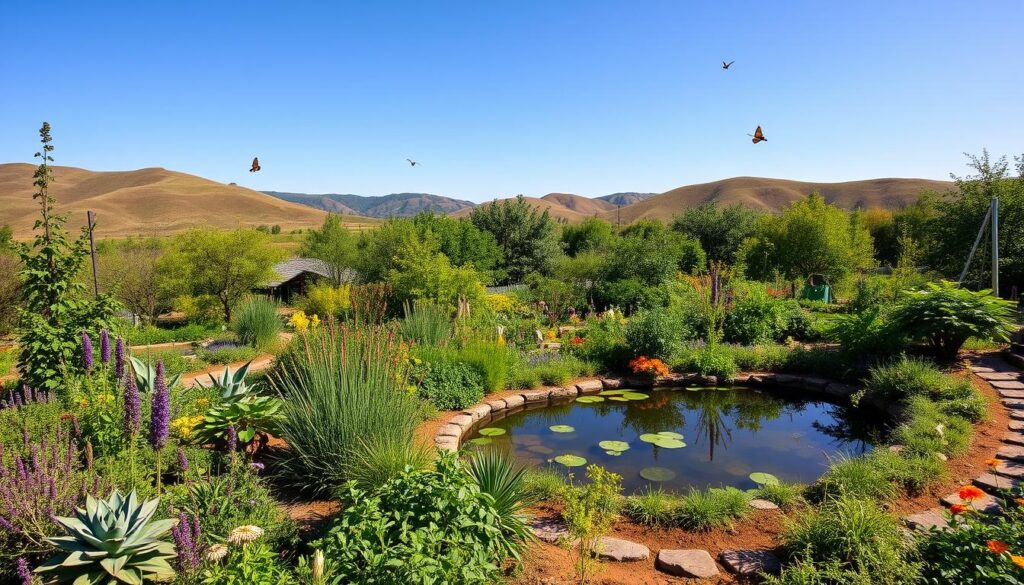
Psychological Benefits of Nature
Being in nature is great for our minds. Studies show that nature can:
- Reduce stress by up to 75%
- Lower anxiety by about 31%
- Make us feel more connected
“Nature itself is the best physician” – Hippocrates
Healing through Biodiversity
Permaculture designs make diverse ecosystems that help us heal. Therapeutic gardens use this diversity to create healing spaces. These spaces help us feel better by stimulating our senses and emotions.
| Ecosystem Component | Healing Benefit |
|---|---|
| Native Plant Diversity | Reduces stress, enhances mood |
| Water Features | Promotes relaxation, sound therapy |
| Wildlife Interaction | Increases emotional connection |
The Role of Community in Healing
Nature-based therapy is not just for one person. It’s about working together. Permaculture helps people come together, learn, and support each other’s health.
- 83% of community members report increased sense of purpose
- 40% improvement in community interaction
- Enhanced opportunities for personal development
Designing a Healing Space
Permaculture is a new way to make spaces that help both people and nature. It combines natural systems with smart design. This changes how we see our surroundings.
Creating healing spaces needs a deep understanding of nature and human needs. Permaculture offers a complete plan for making places that help our health.
Essential Elements of Permaculture Design
Good permaculture design has a few key parts:
- Watching and learning from nature
- Using resources wisely
- Making spaces that do many things
- Keeping a variety of life forms
Integrating Natural Systems
It’s important to link human spaces with nature. The aim is to design spaces that work with nature, not against it. This way, we get:
- Better air quality
- Natural cooling and heating
- Spaces that help our minds
- Deeper connection to nature
Considerations for Microclimates
“Design is the first signal of human intention” – Bill Mollison
Knowing about microclimates is key in green healthcare design. Each space has its own weather and nature that affects healing. Studying sun, wind, and local nature helps make better healing spaces.
By using permaculture, we can turn healthcare spaces into living systems. These systems support healing and well-being for people and nature.
Sourcing Materials for a Permaculture Project
Creating regenerative landscapes needs careful material choice and green sourcing. Permaculture experts know that starting with eco-friendly materials is key. This helps reduce harm to the environment.
Sustainable Material Selection
Choosing the right materials is vital for permaculture projects. New ways to get resources can be green and smart.
- Prioritize renewable resources
- Choose locally sourced materials
- Select materials with low carbon footprint
- Consider recycled and repurposed options
Local Sourcing Advantages
Using local materials has many perks for green projects. Buying close to home cuts down on emissions and boosts local jobs.
| Local Sourcing Benefit | Environmental Impact |
|---|---|
| Reduced transportation emissions | Lower carbon footprint |
| Support local businesses | Economic resilience |
| Lower material transportation costs | Resource efficiency |
Repurposing and Recycling Strategies
Permaculture projects use smart recycling to cut waste. Turning useless stuff into useful parts is a key idea in green landscapes.
“One person’s waste is another’s building material” – Permaculture Design Principle
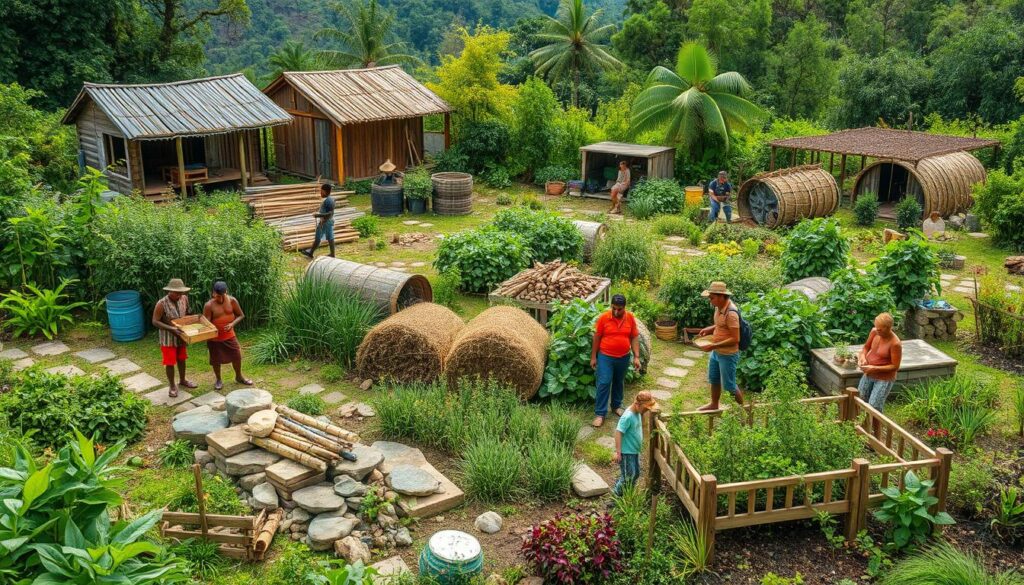
By using these strategies, permaculture folks can make projects that are good for the planet. These efforts help with bigger environmental fixes.
Soil Health and Ecosystem Restoration
Permaculture is a new way to fix and care for soil ecosystems. It’s all about making the soil healthy again. This is key to keeping our environment safe and strong.
Soil health is super important. Studies show that permaculture can make soil up to 30% better. This makes strong ecosystems that help plants and animals thrive.
Techniques for Improving Soil
- Implement ground cover strategies
- Practice minimal soil disturbance
- Integrate diverse plant species
- Utilize natural mulching techniques
The Importance of Composting
Composting is a big deal in making landscapes better. Syntropic farming approaches show how composting helps:
- Increase wildlife populations
- Improve soil nutrient content
- Support climate change mitigation
“Soil is the foundation of life. By nurturing it, we nurture our entire ecosystem.” – Permaculture Design Principle
Biodynamic Practices
Biodynamic farming is all about working with nature. It uses old wisdom and new science to help plants and animals work together. This makes the whole ecosystem better.
| Permaculture Soil Improvement Metric | Potential Impact |
|---|---|
| Soil Organic Matter Increase | Up to 30% |
| Soil Erosion Reduction | 50% compared to conventional farming |
| Biodiversity Enhancement | Up to 100% species variety increase |
Using these methods, we can turn any land into a lively, healthy place. It’s good for the planet and for people too.
Water Management in Permaculture
Water is vital for life and key in making environments restorative. Permaculture uses smart water management to save and use water wisely.
Good water use is vital in farming today. With only 0.5% of Earth’s water for us, we need new ways to protect the environment.
Creating Efficient Water Systems
Smart water management means using clever ways to catch, store, and move water. Important methods include:
- Designing landscape contours to catch rain
- Using swales and berms
- Building underground water storage
- Using gravity to move water
Rainwater Harvesting Techniques
Rainwater harvesting is a strong method for restoring environments. It can save up to 50% of a farm’s water, cutting down on outside water use.
| Technique | Water Savings | Implementation Difficulty |
|---|---|---|
| Roof Collection Systems | 40-60% | Low |
| Swale Infiltration | 30-50% | Medium |
| Underground Cisterns | 50-75% | High |
Benefits of Greywater Recycling
Greywater systems turn home water into useful irrigation. By recycling water from sinks, showers, and laundry, they cut down on fresh water use.
“Water is the driving force of all nature.” – Leonardo da Vinci
Using these water management methods helps restore ecosystems. They make farms strong and self-sustaining, working well with nature’s water cycles.
Incorporating Native Plants for Healing
Permaculture is a way to make healing spaces by using native plants. These plants are key in making therapeutic gardens. They also help connect us with nature through biophilic design.
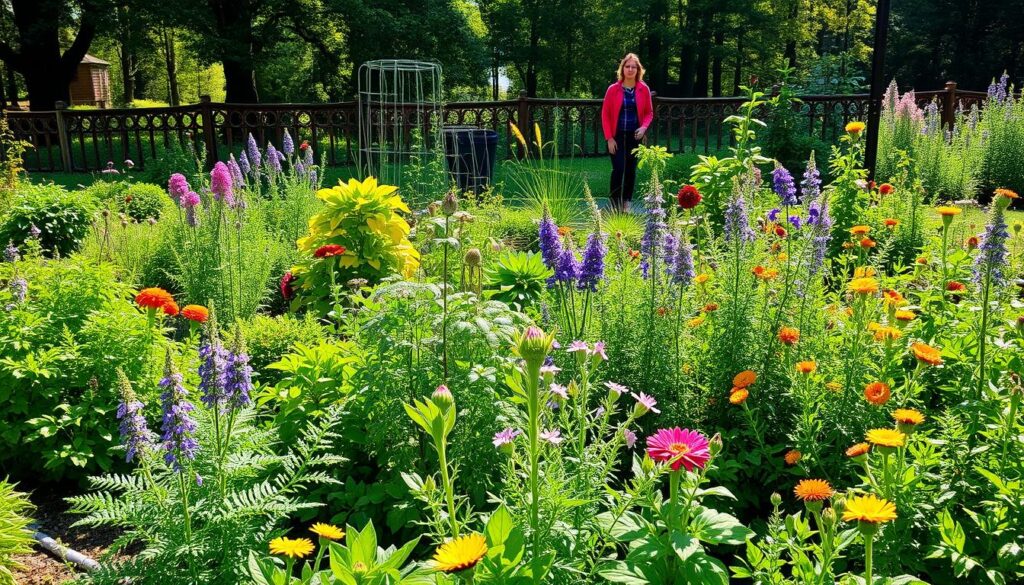
Advantages of Native Flora
Native plants do more than look good. They are very important for our environment. Here’s why:
- Over 90% of plant-eating insects depend on specific native plant species
- Native plants support local wildlife and ecosystem resilience
- They require minimal maintenance and adapt naturally to local conditions
Creating Habitats for Wildlife
Native plants make permaculture designs come alive. For example, native lupines help 64 butterfly and moth species. They also help fix nitrogen in the soil.
“In nature, everything is connected. Native plants are the foundation of local ecological networks.” – Permaculture Design Principle
Medicinal Uses of Native Plants
Indigenous plants have been used for healing for a long time. In California, Native tribes used plants like Camas and Wapato. These plants were for food and medicine.
- Providing food sources like Camas and Wapato
- Supporting traditional medicinal practices
- Contributing to sustainable land management
Therapeutic gardens use native plants to heal both people and the environment. They show how important native plants are for our well-being.
Community Engagement in Permaculture
Permaculture grows when people work together and share what they know. Strong community ties turn individual efforts into big changes for the whole ecosystem. Learning together and supporting each other leads to nature-based therapy.
Green healthcare works best with strong community ties. Local involvement can boost project success by up to 30%. This is thanks to teamwork.
Building a Support Network
To build strong permaculture communities, we need to make connections. Here are some ways to do it:
- Host community garden meetings regularly
- Start local skill-sharing platforms
- Create mentorship programs for newcomers
- Set up ways to share resources
Workshops and Educational Opportunities
Sharing knowledge is key to growing permaculture communities. Workshops help people understand and apply sustainable. They empower folks to change their surroundings for the better.
| Workshop Type | Community Impact | Engagement Potential |
|---|---|---|
| Permaculture Design Courses | High | 65% Participation Rate |
| Urban Gardening Workshops | Medium | 45% Participation Rate |
| Sustainable Living Seminars | Medium-High | 55% Participation Rate |
Sharing Resources and Knowledge
Working together makes us stronger. Sharing resources can increase project success by 20%. This leads to more sustainable and resilient ecosystems.
“The strength of permaculture lies not in individual actions, but in collective transformation.” – Permaculture Design Collective
Adding nature-based therapy to community efforts helps heal people and the environment. It’s a holistic approach to regeneration.
Implementing Ethical Practices
Permaculture is more than just farming. It’s about ethics and caring for the planet and people. It’s about making landscapes better for everyone, not just the land.
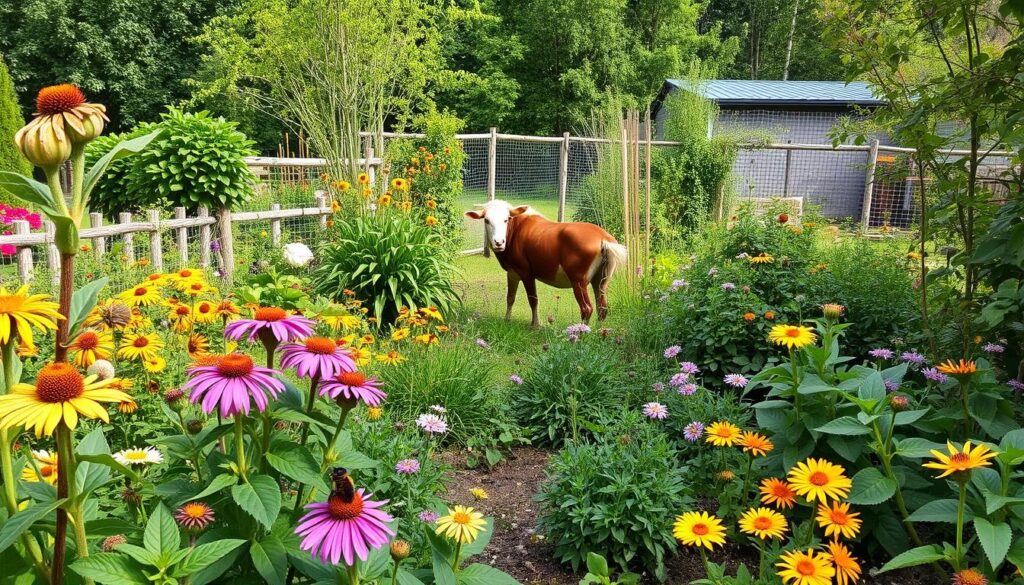
Principles of Fair Trade in Permaculture
Fair trade in permaculture means everyone gets a fair deal. It helps local communities thrive. This way, everyone benefits, not just the landowners.
- Prioritize local economic networks
- Ensure fair compensation for labor
- Promote transparent resource sharing
Avoiding Exploitation in Resource Use
Using resources wisely is key in permaculture. It’s about using less and wasting. This stops harm to the environment and people.
“Give away surplus” is a big idea in permaculture. It’s about sharing and helping each other.
The Importance of Cultural Respect
Restoring the environment means respecting different cultures. Permaculture values people and the planet.
| Cultural Consideration | Permaculture Approach |
|---|---|
| Indigenous Knowledge | Integrate traditional agricultural practices |
| Land Access | Address systemic barriers to participation |
| Community Empowerment | Support local decision-making processes |
Permaculture is more than a design. It’s a way to heal the world and people.
Case Studies: Successful Healing Environments
Permaculture activists are changing landscapes in the United States. They create therapeutic gardens and restorative environments. These show the power of sustainable design in healing communities and nature.
Urban Permaculture Initiatives
Cities are now places for healing environments. Urban permaculture projects are turning unused spaces into green systems. They show that even in busy cities, therapeutic gardens can flourish.
- Transforming vacant lots into productive green spaces
- Creating community-driven agricultural projects
- Developing sustainable food systems in urban settings
Rural Community Gardens
Rural areas are leading in sustainable farming. Studies show permaculture can produce much more than traditional farming. La Ferme du Bec Hellouin is a great example, growing a wide variety of food on just 0.9 acres.
“Reinhabitation is a process of becoming native to a place after disruption, stressing ecological relationships and understanding local environments.”
Notable Projects Across the U.S.
In the United States, many permaculture projects are making a big impact. They follow the principles of caring for people, the environment, and sharing resources.
- Permaculture training centers connecting communities
- Ecological restoration projects
- Sustainable agricultural models
The permaculture movement is growing. It focuses on self-reliant communities and ecological balance. These projects show a hopeful future for sustainability.
Permaculture for Mental and Emotional Well-being
Permaculture is a powerful way to heal the mind and emotions. It turns spaces into places of healing. Nature-based therapy is a key way to find wellness by connecting with nature.
Research shows how nature affects our mental health. Studies found strong links between nature and feeling better:
- 90% of people who garden feel happier
- Gardening can cut depression by 30-40%
- Being in nature lowers stress hormones by up to 16%
Nature Therapy and Its Impact
Nature-based therapy is a whole-body approach to mental health. Being in green spaces has many benefits, like lowering stress and helping emotions. A famous study showed that patients with tree views got better faster and needed less pain meds.
“Connection to nature is not a luxury, but a fundamental human need for emotional healing.” – Environmental Psychology Research
Gardening as a Form of Mindfulness
Gardening is more than growing plants. It’s a way to relax and clear your mind. The hard work helps you sleep better and boosts mood.
Creating Spaces for Reflection
Biophilic design makes spaces for healing. Community gardens and permaculture areas help people feel less lonely. They are places for growth and exploring emotions.
- Soil microbes boost mood
- Outdoor activities improve emotional health
- Natural settings reduce stress
Future of Permaculture in Environmental Healing
The world of green healthcare and ecological restoration is changing fast. Permaculture is becoming a key way to live sustainably. As big problems grow, we need new solutions to help our environment and communities.
New trends in permaculture are changing how we heal the environment and develop sustainably. By mixing new tech with old wisdom, we’re finding new ways to make communities strong.
Trends and Innovations
New ideas in permaculture are leading the way in sustainable living. Some key trends include:
- Advanced digital mapping for ecological design
- Climate-adaptive agricultural techniques
- Community-scale regenerative systems
The Role of Technology in Permaculture
Technology is changing ecological restoration with smart tools that boost permaculture. Precision agriculture and using data to manage the environment are getting better.
| Technology | Impact on Permaculture |
|---|---|
| Satellite Mapping | Improved land use planning |
| Drone Technology | Precise ecosystem monitoring |
| AI Environmental Analysis | Enhanced biodiversity tracking |
Vision for Sustainable Communities
“The future of sustainable living lies in our ability to work with nature, not against it.” – Permaculture Design Expert
Permaculture has a big vision for sustainable communities. It has the power to tackle global problems. Here are some stats that show its impact:
- Local food production can increase community food security by up to 30%
- Permaculture techniques can reduce soil erosion by 75%
- Carbon sequestration can increase by 12% through strategic plant integration
The future of green healthcare and ecological restoration looks bright. Permaculture is leading the way to more resilient and regenerative systems. These systems will heal both people and the planet.
Getting Started with Your Own Permaculture Project
Starting a permaculture project turns any space into a thriving garden. It’s perfect for small balconies or big rural areas. It’s all about making sustainable living a reality.
To start a permaculture project, you need a good plan. Here are the key steps to get you going:
- Check out your space and the local weather
- Watch how nature works and interacts
- Plan with purpose and be open to changes
- Begin small and grow your project
Essential Learning Resources
Learning is key to permaculture success. Here are some great resources to learn from:
- Online permaculture design courses
- Local workshops and training programs
- Permaculture books and publications
- Community learning networks
Connecting with Local Permaculture Communities
Getting support can really help you grow your garden. Here are ways to connect:
| Connection Method | Benefits |
|---|---|
| Social Media Groups | Quick access to expert tips |
| Regional Permaculture Associations | Chances to network and share skills |
| Local Gardening Clubs | Hands-on learning and community backing |
“The best time to start your permaculture journey is now, with what you have, where you are.” – Permaculture Design Principle
Creating a permaculture garden is a journey of learning. Be open to trying new things, adapt, and celebrate every small win.
Conclusion: The Synergy of Healing and Permaculture
Permaculture is a new way to make healing spaces that connect us with nature. It started with Franklin Hiram King’s idea of permanent agriculture in 1911. Now, it’s a global movement that shows how design can work with nature.
Permaculture healing spaces do more than just grow plants. They also include activities like forest bathing for better health. This approach helps us feel connected to nature and improves our well-being.
Studies show permaculture gardening boosts biodiversity by 30-50% and cuts water use by up to 50%. It also helps with carbon sequestration, mental health, and fixing ecosystems. People who practice permaculture see big improvements in their health and the environment.
Reclaiming Our Connection with Nature
It’s time for us and our communities to use permaculture for healing. By making spaces that support nature and people, we can build strong systems. Permaculture shows us how to fix our relationship with nature and help the planet.
Call to Community Action
Every garden and community project is a chance to use permaculture. Small urban gardens or big landscape designs all help in fixing the environment. Join local permaculture groups, go to workshops, and try sustainable design at home. Together, we can heal the planet by working with nature.

